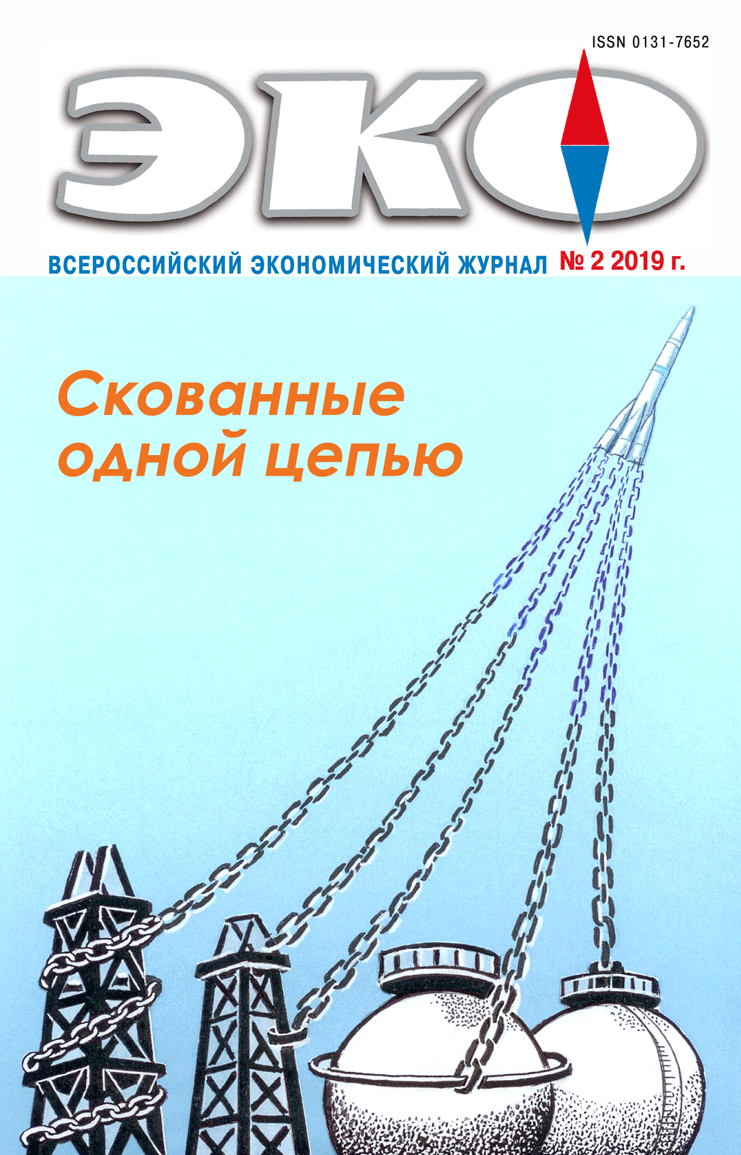ТЕМА НОМЕРА: СКОВАННЫЕ ОДНОЙ ЦЕПЬЮ
Published 2019-01-31
Keywords
- Structural instability,
- cyclical instability,
- basic innovations,
- economic growth,
- technological structure
- economic cycles,
- nonlinearity of economic cycles ...More
How to Cite
1.
Gasanov М, Ghironkin С, Guzyry В, Ghavoronok А. Structural-and-Cyclical Approach to Technological Renewal of the Russian Economy. ECO [Internet]. 2019 Jan. 31 [cited 2025 Dec. 16];49(2):8-21. Available from: https://ecotrends.ru/index.php/eco/article/view/1781
Abstract
The article deals with the phenomenon of deepening cyclical and structural instability of Russian economy, which has a negative impact on technological modernization and economic growth. According to the authors, the basis of economic cycles is a system of structural shifts of different directions and the expansion of contradictions in “structural crisis – structural shift” system. A structural-and-cyclical approach is proposed, revealing the nature of cyclicity, not only using its impact on structural shifts, technologies, investments (internal factors), but also through influence of external factors that lead to a qualitative transformation of the economic system. Based on the declared approach, the authors concluded that the depth of economic losses, the degeneracy of innovation, structural and technological sources of Russian economy is due to a high degree of market entropy, the prevalence of negative externalities in the economy, the imitative nature of institutional structures, the inertia of economic relations. All these negative factors are de-stimulating for technological modernization and force de-industrialization trend. The proposed approach allows establishing the genetic relationship between structural dynamics and cyclic fluctuations, reveals the dialectic of the impact of cyclic intervention on structural parameters and reverse influence of structural correlations (stability and instability) on the depth and nature of the cycle as a whole, on interphase and intraphase transitions in particular. Obviously, in this case, the research object is expanded, the model of interaction between the cycle and the structure of the economy becomes clearer, which makes it possible to identify algorithms for their interrelation and influence on macroeconomic indicators. The features of the impact of cyclical dynamics on structural shifts of the economy are determined: the shift is the primary structural determinant. It has been substantiated that the structural cycle of Russian economy is deformed, since the crisis does not eliminate disproportions in the economic structure but acquires features of a degenerative type of transformation. In conditions of increasing cyclical and structural instability, the integrated model of structural-and-anticyclical policy acquires special significance. To change the trajectory of Russia’s economic development, an integrated model of counter-cyclical and structural policies is needed.References
- Акаев А. А., Румянцева С. Ю., Сарыгулов А. И., Соколов В. Н. Структурно-циклические процессы экономической динамики. Санкт-Петербург: Санкт-Петербургский политехнический университет им. Петра Великого, 2016. 392 с.
- Гасанов М. А. Структурные сдвиги в условиях трансформации экономики России и становления инновационного типа развития: дисс. д-ра экон. наук. Томск: 2012. 384 с.
- Ерохина Е. А., Маркина А. В. Циклы Н. Д. Кондратьева в структурных сдвигах в экономике развитых стран // Вестник ТГПУ. 2005. № 5 (49). Гуманитарные науки (Экономика). С. 47–50.
- Инновационное развитие: экономика, интеллектуальные ресурсы, управление знаниями / Под ред. Б. З. Мильнера. М.: ИНФРА-М, 2009. 624 с.
- Иохин В. Я. Экономическая теория: учеб. для вузов. М.: Экономистъ, 2006. 861 с.
- Клейнер Г. Б. Устойчивость российской экономики в зеркале системной экономической теории (часть 1) // Вопросы экономики. 2015. № 12. С. 107–123.
- Князев Ю. К. Глобальный кризис и его уроки. Научный доклад. М.: ИЭ РАН, 2010. 42 с.
- Колотов К. А., Жиронкин С. А., Гасанов М. А. Экономические, технологические и социальные основы неоиндустриального импортозамещения. Томск: STT Publishing, 2016. 210 с.
- Садовничий В. А., Акаев А. А., Коротаев А. В., Малков С. Ю. Моделирование и прогнозирование мировой динамики. М.: ИСПИ РАН, 2012. 359 с.
- Цветков В. А. Циклы и кризисы: теоретико-методологичкский аспект. М.-СПб.: Нестор-История, 2012. 510 с.
- Шумпетер И. Теория экономического развития. М.: Прогресс, 1982. 455 с.

